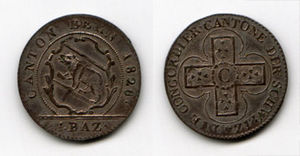Billon
Billon (of medium latin Billio "Zahlgut") is an alloy of copper and silver , the silver content is less than 500/1000 (50%). A billon alloy can also contain other base metals such as tin or zinc . Billon was used for small change and token coins . You can recognize it by its slightly darker, reddish appearance compared to silver.
Concept history
The word billon first appeared in France in the 13th century and stood for unminted metal ; a meaning that persists in the English-speaking word bullion , which is still used today . In the 15th century the term was transferred to metal masses and coins that contained little precious metal .
History of the billon coins
Billon coins have been around since ancient times . While the first billon coins of the cities of the Greek island of Lesbos from the 6th and early 5th centuries BC Consisting of a natural silver-copper alloy, most of the Carthaginian , Persian , Ptolemy , Roman , Byzantine , medieval and early modern billon coins were the result of coin deterioration.
Frequently Billonmünzen were before delivery from the mint in a silver nitrate - Weinstein solution "white boiled", making them with a thin fine silver layer were coated and received so the appearance of a full-fledged silver coin. However, this was rubbed off after a short period of circulation, so that a reddish copper shimmer remained. Another method to hide the bad silver content of the coin was pickling with a short polishing, which removed copper from the surface of the coin and gave it an initially shiny silver glow.
Since the end of the Middle Ages, coins made of billon alloys have been minted for the smaller denominations in Germany and other countries for inflationary reasons or for reasons of additional money being raised by many minters , which was initially done covertly. In the 16th and 17th centuries, they prepared the transition to the divisional coin and were the main means of payment for the poorer classes of the population. In times of inflation , such as the Kipper and Wipper times around 1620, smaller, former Kurant coins made of silver gradually became billon coins due to constant coin deterioration, before they were then only made of copper.
Since the 17th century, small and many coins have been minted mostly in billons, for example the Prussian silver groschen from 1821 to 1873, the Saxon new groschen from 1841 to 1873 or the Swiss 5, 10 and 20 cents coins from 1850 until 1877.
The billon coin must not be confused with the similar-sounding bullion coin , the modern investment coin .
See also
- Electron , a natural gold-silver alloy
Individual evidence
- ↑ Helmut Kahnt: Billon coin . In the S. (Ed.): The great coin lexicon. From A to Z , Regenstauf 2005, p. 50.
- ^ Benedikt Zäch: Billon. In: Historical Lexicon of Switzerland . October 14, 2010 , accessed October 9, 2012 .
- ↑ Friedrich v. Schrötter: Billon . In: Ders. (Ed.): Dictionary der Münzkunde , Berlin / Leipzig 1930, pp. 74f.
- ↑ Friedrich v. Schrötter: Billon-M. In: Ders. (Ed.): Dictionary der Münzkunde , Berlin / Leipzig 1930, p. 75.
